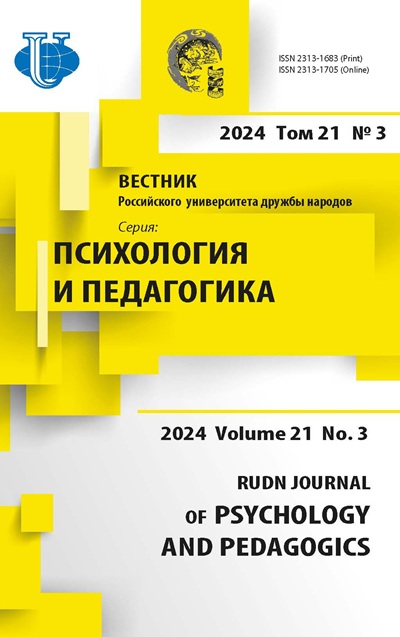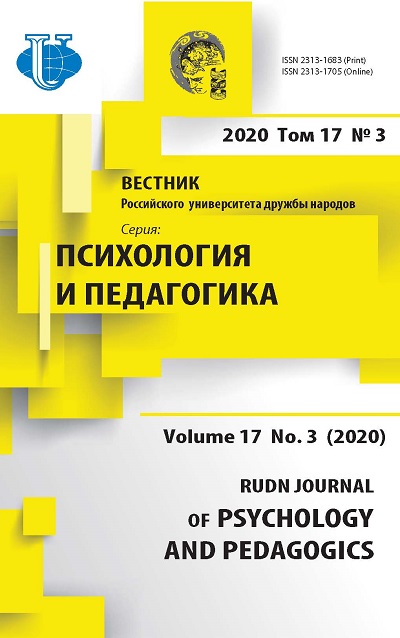Questionnaire on Assessing Individual Vulnerability to Cyberbullying: Development and Preliminary Validation
- Authors: Sheinov V.P.1
-
Affiliations:
- Republican Institute of Higher Education
- Issue: Vol 17, No 3 (2020)
- Pages: 521-541
- Section: SOCIAL PSYCHOLOGY IN CULTURAL DIMENSIONS
- URL: https://journals.rudn.ru/psychology-pedagogics/article/view/24718
- DOI: https://doi.org/10.22363/2313-1683-2020-17-3-521-541
Cite item
Full Text
Abstract
Cyberbullying is manifested in repeated deliberate acts of aggression by one or more persons who use electronic means of communication to attack a victim who cannot defend him- or herself. Cyberbullying is a form of violence through harassment, insults, bullying, humiliation or intimidation carried out using the Internet, mobile phones and other electronic devices. Cyberbullying is widespread and causes severe harm to its victims, having a negative impact on their mental and physical health. The purpose of this study is to develop a reliable and valid questionnaire on assessing individual vulnerability to cyberbullying. The article constructs such a questionnaire and proves that it meets the standard reliability criteria: internal consistency, homogeneity and retest reliability. It is shown that the questionnaire is valid and satisfies the key validity criteria: validation in the process of designing the questionnaire, substantive, constructive and convergent validity. The questionnaire is standardised, the norms for young men and women are given, presented in average values and standard deviations. The theoretical basis of the study is the model of manipulative influence (which includes cyberbullying) and the psychological mechanism of cyberbullying described by this model. Confirmatory factor analysis showed that the model of the presented questionnaire has good indicators of reliability and statistical consistency. The experimental part of the study involved 307 young men and women at the ages from 17 to 21 years old - students of medical colleges and cadets of the University of the Ministry of Emergencies. The study included two stages of psychodiagnostics of the subjects carried out with an interval of two months. The states of individuals vulnerable to cyberbullying, identified using the questionnaire, are consistent with the results obtained in previous studies. The proposed questionnaire makes it possible to warn an individual about the existing or threatening danger of becoming a victim of cyberbullying. The questionnaire can stimulate the study of cyberbullying in the Russian-speaking society and, in particular, in cross-cultural studies.
About the authors
Viktor P. Sheinov
Republican Institute of Higher Education
Author for correspondence.
Email: sheinov1@mail.ru
D.Sc. in Sociology, Full Professor, is Professor at the Department of Psychology and Pedagogical Excellence
15 Moskovskaya St, Minsk, 220001, Republic of BelarusReferences
- Anastasi, A., & Urbina, S. (2002). Psychological Testing (7th ed.). Saint Petersburg: Piter Publ. (In Russ.)
- Antoniadou, N., Kokkinos, C.M., & Markos, A. (2016). Development, construct validation and measurement invariance of the Greek cyber-bullying/victimization experiences questionnaire (CBVEQ-G). Computers in Human Behavior, 65, 380–390. https://doi.org/10.1016/j.chb.2016.08.032
- Belkovec, O.S. (2016). The phenomenon of cyberbullying among teenagers on social media. Vescі BDPU. Seryya 1, (2), 46–49. (In Russ.)
- Bochaver, A.A., Dokuka, S.V., Sivak, E.V., & Smirnov, I.B. (2019). Internet use and depressive symptoms in adolescents: A review. Clinical Psychology and Special Education, 8(3), 1–18. http://doi.org/10.17759/psyclin.2019080301 (In Russ.)
- Borrajo, E., Gámez-Guadix, M., Pereda, N., & Calvete, E. (2015). The development and validation of the cyber dating abuse questionnaire among young couples. Computers in Human Behavior, 48, 358–365. https://doi.org/10.1016/j.chb.2015.01.063
- Buelga, S., & Pons, J. (2012). Agresiones entre Adolescentes a través del Teléfono Móvil y de Internet. Psychosocial Intervention, 91–101. https://doi.org/10.5093/in2012v21n1a2
- Buelga, S., Cava, M.J., Musitu, G., & Torralba, E. (2015). Cyberbullying aggressors among Spanish secondary education students: An exploratory study. Interactive Technology and Smart Education, 12(2), 100–115. https://doi.org/10.1108/itse-08-2014-0025
- Buelga, S., Martínez-Ferrer, B., Cava, M.J., & Ortega-Barón, J. (2019). Psychometric properties of the CYBVICS cyber-victimization scale and its relationship with psychosocial variables. Social Sciences, 8(1), 13. https://doi.org/10.3390/socsci8010013
- Buelga, S., Postigo, J., Martínez-Ferrer, B., Cava, M., & Ortega-Barón, J. (2020). Cyberbullying among adolescents: Psychometric properties of the CYB-AGS Cyber-Aggressor Scale. International Journal of Environmental Research and Public Health, 17(9), 3090. https://doi.org/10.3390/ijerph17093090
- Burlachuk, L.F. (2010). Psihodiagnostika. Saint Petersburg: Piter Publ. (In Russ.)
- Burlachuk, L.F., & Morozov, S.M. (2004). Spravochnik po Psihodiagnostike. Saint Petersburg: Piter Publ. (In Russ.)
- Calvete, E., Orue, I., Estévez, A., & Villardón, L. (2010). Cyberbullying in adolescents: Modalities and aggressors' profile. Computers in Human Behavior, 26(5), 1128–1135. https://doi.org/10.1016/j.chb.2010.03.017
- Casas, J.A., Rey, R.D., & Ortega-Ruiz, R. (2013). Bullying and cyberbullying: Convergent and divergent predictor variables. Computers in Human Behavior, 2(3), 580–587. https://doi.org/10.1016/j.chb.2012.11.015
- Cerny, B.A., & Kaiser, H.F. (1977). A study of a measure of sampling adequacy for factor-analytic correlation matrices. Multivariate Behavioral Research, 12(1), 43–47. https://doi.org/10.1207/s15327906mbr1201_3
- Chen, L., Ho, S., & Lwin, M.O. (2017). A meta-analysis of factors predicting cyberbullying perpetration and victimization: From the social cognitive and media effects approach. New Media & Society, 19(8), 1194–1213. https://doi.org/10.1177/1461444816634037
- Del Rey, R., Casas, J.A., Ortega-Ruiz, R., et al. (2015). Structural validation and cross-cultural robustness of the European Cyberbullying Intervention Project Questionnaire. Computers in Human Behavior, 50, 141–147. https://doi.org/10.1016/j.chb.2015.03.065
- Gini, G., & Espelage, D.L. (2014). Peer victimization. Cyberbullying and suicide risk in children and adolescents. JAMA, 312(5), 545–546. https://doi.org/10.1001/jama.2014.3212
- González-Cabrera, J.M., León-Mejía, A., Machimbarrena, J.M., Balea, A., & Calvete, E. (2019). Psychometric properties of the cyberbullying triangulation questionnaire: A prevalence analysis through seven roles. Scandinavian Journal of Psychology, 60(2), 160–168. https://doi.org/10.1111/sjop.12518
- HADS, Hospital Anxiety and Depression Scale. (2002). In A.N. Belova, & O.N. Shchepetova (Eds.), Shkaly, Testy i Oprosniki v Meditsinskoi Reabilitatsii (pp. 80–82). Moscow: Antidor Publ. (In Russ.)
- Hinduja, S., & Patchin, J.W. (2014). Cyberbullying: Identification, Prevention, & Response. Cyberbullying Research Center. Retrieved May 22, 2019, from https://cyberbullying.org/Cyberbullying-Identification-Prevention-Response-2018.pdf
- Jönsson, S., Muhonen, T., Cowen Forssell, R., & Bäckström, M. (2017). Assessing exposure to bullying through digital devices in working life: Two versions of a cyberbullying questionnaire (CBQ). Psychology, 8(3), 477–494. https://doi.org/10.4236/psych.2017.83030
- Katzer, C., Fetchenhauer, D., & Belschak, F. (2009). Cyberbullying: Who are the victims? A comparison of victimization in internet chatrooms and victimization in school. Journal of Media Psychology, 21(1), 25–36. https://doi.org/10.1027/1864-1105.21.1.25
- Khlomov, K.D., Davydov, D.G., & Bochaver, A.A. (2019). Cyberbullying in the experience of Russian teenagers. Psychology and Law, 9(2), 276–295. http://doi.org/10.17759/psylaw.2019090219 (In Russ.)
- Little, T.D., Henrich, C.C., Jones, S.M., & Hawley, P.H. (2003). Disentangling the “whys” from the “whats” of aggressive behavior. International Journal of Behavioral Development, 27(2), 122–130. https://doi.org/10.1080/01650250244000128
- Marchenko, F.O., & Makhovskaya, O.I. (2018). Psychology of network aggression (cyberbullying) during an epidemic of narcissism. Human Being: Image and Essence. Humanitarian Aspects, (4), 100–119. (In Russ.)
- Menesini, E., Nocentini, A., & Calussi, P. (2011). The measurement of cyberbullying: Dimensional structure and relative item severity and discrimination. Cyberpsychology, Behavior, and Social Networking, 14(5), 267–274. https://doi.org/10.1089/cyber.2010.0002
- Mishna, F., Khoury-Kassabri, M., Schwan, K., Wiener, J., Craig, W., Beran, T., Pepler, D., & Daciuk, J. (2016). The contribution of social support to children and adolescents' self-perception: The mediating role of bullying victimization. Children and Youth Services Review, 63, 120–127. https://doi.org/10.1016/j.childyouth.2016.02.013
- Osin, E.N., & Leontyev, D.A. (2008). Aprobatsiya russkoyazychnykh versii dvukh shkal ekspress-otsenki sub"ektivnogo blagopoluchiya. Proceedings of of the 3rd All-Russian Sociological Congress. Moscow: Institut sotsiologii RAN. Retrieved February 25, 2019, https://publications.hse.ru/mirror/pubs/share/folder/pjuun7fz60/direct/78753837.pdf (In Russ.)
- Peluchette, J.V., Karlb, K., Wood, Ch., & Williams, J. (2015). Cyberbullying victimization: Do victims’ personality and risky social network behaviors contribute to the problem? Computers in Human Behavior, 52, 424–435. https://doi.org/10.1016/j.chb.2015.06.028
- Perren, S., Dooley, J., Shaw, T., & Cross, D. (2010). Bullying in school and cyberspace: Associations with depressive symptoms in Swiss and Australian adolescents. Child and Adolescent Psychiatry and Mental Health, 4(1), 28. https://doi.org/10.1186/1753-2000-4-28
- Privitera, C., & Campbell, M.A. (2009). Cyberbullying: The new face of workplace bullying? CyberPsychology & Behavior, 12(4), 395–400. https://doi.org/10.1089/cpb.2009.0025
- Schneider, S.K., O'Donnell, L., Stueve, A., & Coulter, R.W.S. (2012). Cyberbullying, School Bullying, and Psychological Distress: A Regional Census of High School Students. American Journal of Public Health, 102(1), 171–177. https://doi.org/10.2105/ajph.2011.300308
- Sheinov, V.P. (2011). Psikhologiya Manipulirovaniya (3rd edition). Moscow: AST Publ.; Minsk: Kharvest Publ. (In Russ.)
- Sheinov, V.P. (2012). Development of a questionnaire to assess the degree of vulnerability of the individual against manipulative influences. Voprosy Psikhologii, (4), 147–154. (In Russ).
- Sheinov, V.P. (2019а). Cyberbulling: Prerequisite and implications. Institute of Psychology Russian Academy of Sciences. Social and Economic Psychology, 4(2), 77–98. (In Russ.)
- Sheinov, V.P. (2019б). Victimization of mockeries’ victims as the source of their negative emotional states. Institute of Psychology Russian Academy of Sciences. Social and Economic Psychology, 4(1), 94–123. (In Russ.)
- Sheinov, V.P. (2019в). Intrapersonal predictors of victimization. Institute of Psychology Russian Academy of Sciences. Organizatsionnaya Psikhologiya i Psikhologiya Truda, 4(1), 154–182. (In Russ.)
- Smith, P., Mahdavi, J., Carvalho, M., & Tippett, N. (2006). An investigation
- into cyberbullying, its forms, awareness and impact, and the relationship
- between age and gender in cyberbullying. Retrieved June 14, 2020, from http://www.antibullyingalliance.org/ResearchEvaluationTeamResarchReport.htm
- Soldatova, G., Rasskazova, E., Zotova, E., Lebesheva, M., & Roggendorf, P. (2012).Children of Russia Online: Risks and Safety. Results of the international project EU Kids Online II in Russia. Retrieved July 3, 2017, from http://detionline.com/assets/files/helplineRussianKidsOnline_Final%20ReportRussian.pdf (In Russ.)
- Soldatova, G.U., & Yarmina, A.N. (2019). Cyberbullying: Features, role structure, parent-child relationships and coping strategies. National Psychological Journal, (3), 17–31. http://doi.org/10.11621/npj.2019.0303 (In Russ.)
- Sticca, F., Machmutow, K., Stauber, A., & Perren, S. (2015). The coping with Cyberbullying Questionnaire: Development of a new measure. Societies, 5(2), 515–536. https://doi.org/10.3390/soc5020515
- Strukov, V.S., Stefanovic, Yu., & Popova, L.G. (2018). Risk-analiz of kiberbulling fenomena in the events of social network VKontakte. Informatsiya i Bezopasnost', 21(3), 416–419. (In Russ.)
- Wilsem, J. (2013). ‘Bought it, but Never Got it’ Assessing Risk Factors for Online Consumer Fraud Victimization. European Sociological Review, 29(2), 168–178. https://doi.org/10.1093/esr/jcr053
- Wong, R.Y.M., Cheung, C.M.K., & Xiao, B. (2018). Does gender matter in cyberbullying perpetration? An empirical investigation. Computers in Human Behavior, 79, 247–257. https://doi.org/10.1016/j.chb.2017.10.022
- Young, K.S. (1999). Internet addiction: symptoms, evaluation and treatment. Innovations in Clinical Practice. A Source Book (vol. 17, pp. 19–31). Sarasota, FL: Professional Resource Press.
















